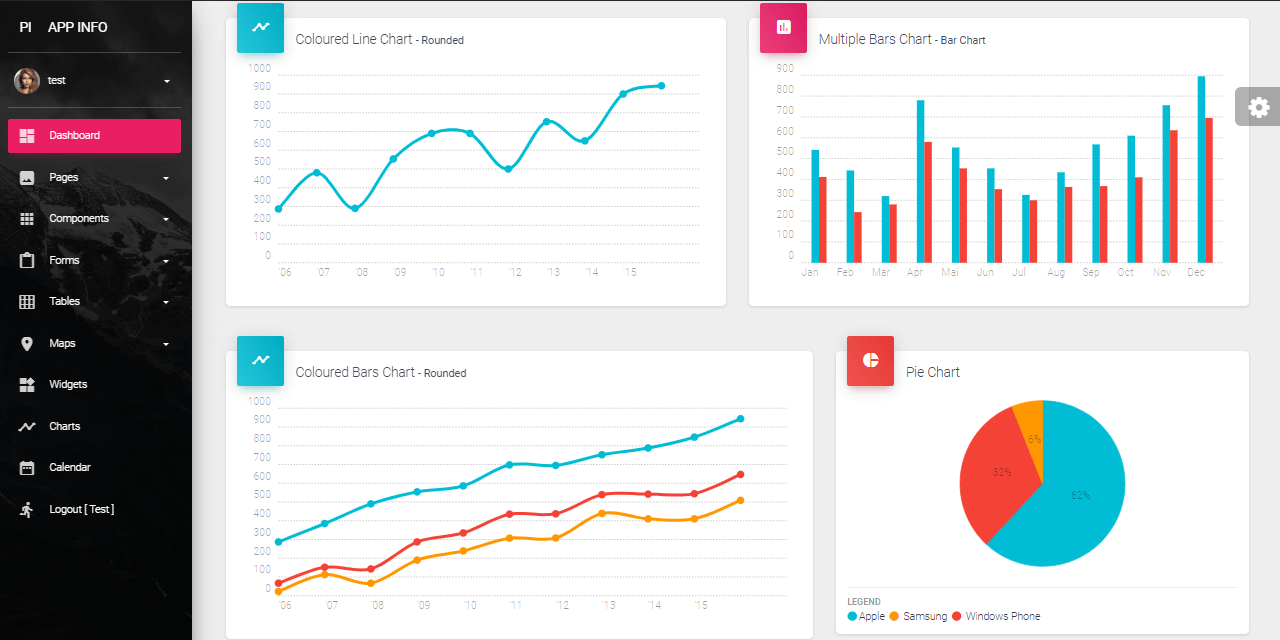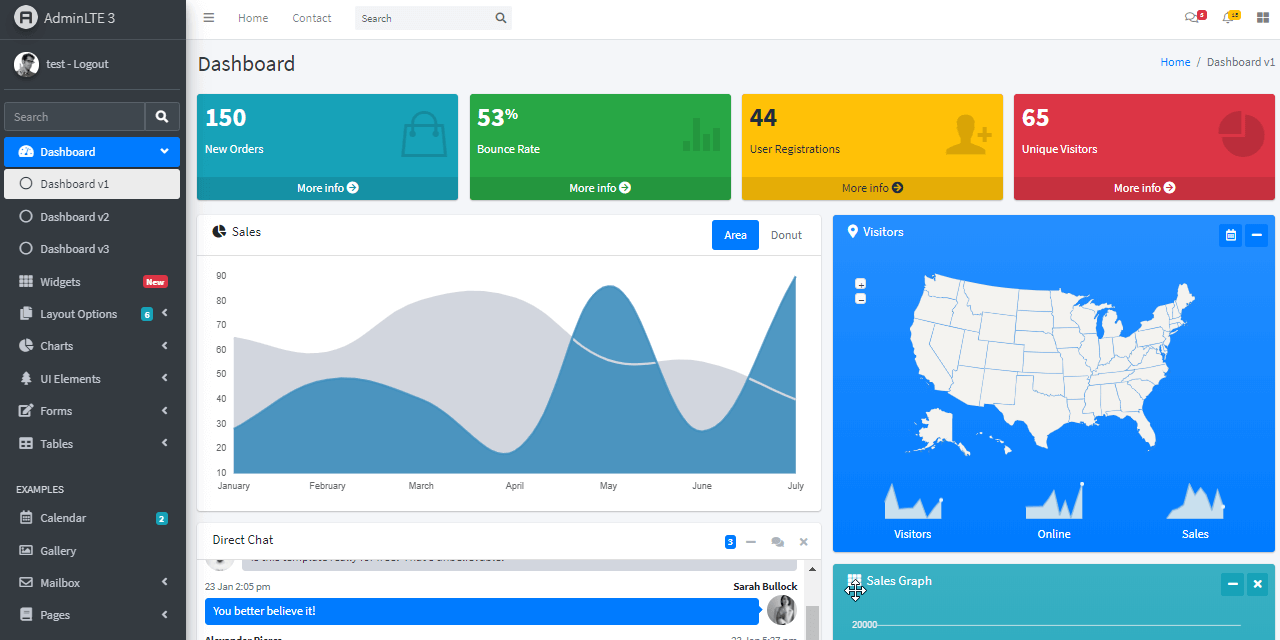# flask-dashboard-adminlte
**Repository Path**: rainfallstickgrassy/flask-dashboard-adminlte
## Basic Information
- **Project Name**: flask-dashboard-adminlte
- **Description**: AdminLTE Flask - Open-source Seed Project | AppSeed
- **Primary Language**: Unknown
- **License**: Not specified
- **Default Branch**: master
- **Homepage**: None
- **GVP Project**: No
## Statistics
- **Stars**: 1
- **Forks**: 0
- **Created**: 2021-05-08
- **Last Updated**: 2023-01-17
## Categories & Tags
**Categories**: Uncategorized
**Tags**: None
## README
# AdminLTE Flask
[AdminLTE Flask](https://appseed.us/admin-dashboards/flask-dashboard-adminlte) is an open-source seed project generated by AppSeed on top of **AdminLTE**, the iconic dashboard design. For newcomers, AdminLTE is one of the best open-source admin dashboard & control panel theme. Built on top of Bootstrap, AdminLTE provides a range of responsive, reusable, and commonly used components. Flask provides a lightweight codebase that can be easily extended to become an API, a simple web app, or a complex eCommerce platform.
> Features
- DBMS: SQLite, PostgreSQL (production)
- DB Tools: SQLAlchemy ORM, Flask-Migrate (schema migrations)
- Modular design with **Blueprints**, simple codebase
- Session-Based authentication (via **flask_login**), Forms validation
- Deployment scripts: Docker, Gunicorn / Nginx, Heroku
> Links
- [AdminLTE Flask](https://appseed.us/admin-dashboards/flask-dashboard-adminlte) - product page
- [AdminLTE Flask](https://adminlte-flask.appseed-srv1.com/) - LIVE Deployment
- [AdminLTE Flask](https://docs.appseed.us/products/flask-dashboards/adminlte) - product documentation
## Want more? Go PRO!
PRO versions include **Premium UI Kits**, Lifetime updates and **24/7 LIVE Support** (via [Discord](https://discord.gg/fZC6hup))
| [Flask Datta PRO](https://appseed.us/admin-dashboards/flask-dashboard-dattaable-pro) | [Flask Material PRO](https://appseed.us/admin-dashboards/flask-dashboard-material-pro) | [Flask Volt PRO](https://appseed.us/admin-dashboards/flask-dashboard-volt-pro) |
| --- | --- | --- |
| [](https://appseed.us/admin-dashboards/flask-dashboard-dattaable-pro) | [](https://appseed.us/admin-dashboards/flask-dashboard-material-pro) | [](https://appseed.us/admin-dashboards/flask-dashboard-volt-pro)

## How to use it
```bash
$ # Get the code
$ git clone https://github.com/app-generator/flask-dashboard-adminlte.git
$ cd flask-dashboard-adminlte
$
$ # Virtualenv modules installation (Unix based systems)
$ virtualenv env
$ source env/bin/activate
$
$ # Virtualenv modules installation (Windows based systems)
$ # virtualenv env
$ # .\env\Scripts\activate
$
$ # Install modules - SQLite Database
$ pip3 install -r requirements.txt
$
$ # OR with PostgreSQL connector
$ # pip install -r requirements-pgsql.txt
$
$ # Set the FLASK_APP environment variable
$ (Unix/Mac) export FLASK_APP=run.py
$ (Windows) set FLASK_APP=run.py
$ (Powershell) $env:FLASK_APP = ".\run.py"
$
$ # Set up the DEBUG environment
$ # (Unix/Mac) export FLASK_ENV=development
$ # (Windows) set FLASK_ENV=development
$ # (Powershell) $env:FLASK_ENV = "development"
$
$ # Start the application (development mode)
$ # --host=0.0.0.0 - expose the app on all network interfaces (default 127.0.0.1)
$ # --port=5000 - specify the app port (default 5000)
$ flask run --host=0.0.0.0 --port=5000
$
$ # Access the dashboard in browser: http://127.0.0.1:5000/
```
> Note: To use the app, please access the registration page and create a new user. After authentication, the app will unlock the private pages.
## Code-base structure
The project is coded using blueprints, app factory pattern, dual configuration profile (development and production) and an intuitive structure presented bellow:
> Simplified version
```bash
< PROJECT ROOT >
|
|-- app/ # Implements app logic
| |-- base/ # Base Blueprint - handles the authentication
| |-- home/ # Home Blueprint - serve UI Kit pages
| |
| __init__.py # Initialize the app
|
|-- requirements.txt # Development modules - SQLite storage
|-- requirements-mysql.txt # Production modules - Mysql DMBS
|-- requirements-pqsql.txt # Production modules - PostgreSql DMBS
|
|-- .env # Inject Configuration via Environment
|-- config.py # Set up the app
|-- run.py # Start the app - WSGI gateway
|
|-- ************************************************************************
```
> The bootstrap flow
- `run.py` loads the `.env` file
- Initialize the app using the specified profile: *Debug* or *Production*
- If env.DEBUG is set to *True* the SQLite storage is used
- If env.DEBUG is set to *False* the specified DB driver is used (MySql, PostgreSQL)
- Call the app factory method `create_app` defined in app/__init__.py
- Redirect the guest users to Login page
- Unlock the pages served by *home* blueprint for authenticated users
> App / Base Blueprint
The *Base* blueprint handles the authentication (routes and forms) and assets management. The structure is presented below:
```bash
< PROJECT ROOT >
|
|-- app/
| |-- home/ # Home Blueprint - serve app pages (private area)
| |-- base/ # Base Blueprint - handles the authentication
| |-- static/
| | |-- # CSS files, Javascripts files
| |
| |-- templates/ # Templates used to render pages
| |
| |-- includes/ #
| | |-- navigation.html # Top menu component
| | |-- sidebar.html # Sidebar component
| | |-- footer.html # App Footer
| | |-- scripts.html # Scripts common to all pages
| |
| |-- layouts/ # Master pages
| | |-- base-fullscreen.html # Used by Authentication pages
| | |-- base.html # Used by common pages
| |
| |-- accounts/ # Authentication pages
| |-- login.html # Login page
| |-- register.html # Registration page
|
|-- requirements.txt # Development modules - SQLite storage
|-- requirements-mysql.txt # Production modules - Mysql DMBS
|-- requirements-pqsql.txt # Production modules - PostgreSql DMBS
|
|-- .env # Inject Configuration via Environment
|-- config.py # Set up the app
|-- run.py # Start the app - WSGI gateway
|
|-- ************************************************************************
```
> App / Home Blueprint
The *Home* blueprint handles UI Kit pages for authenticated users. This is the private zone of the app - the structure is presented below:
```bash
< PROJECT ROOT >
|
|-- app/
| |-- base/ # Base Blueprint - handles the authentication
| |-- home/ # Home Blueprint - serve app pages (private area)
| |
| |-- templates/ # UI Kit Pages
| |
| |-- index.html # Default page
| |-- page-404.html # Error 404 - mandatory page
| |-- page-500.html # Error 500 - mandatory page
| |-- page-403.html # Error 403 - mandatory page
| |-- *.html # All other HTML pages
|
|-- requirements.txt # Development modules - SQLite storage
|-- requirements-mysql.txt # Production modules - Mysql DMBS
|-- requirements-pqsql.txt # Production modules - PostgreSql DMBS
|
|-- .env # Inject Configuration via Environment
|-- config.py # Set up the app
|-- run.py # Start the app - WSGI gateway
|
|-- ************************************************************************
```
## Deployment
The app is provided with a basic configuration to be executed in [Docker](https://www.docker.com/), [Heroku](https://www.heroku.com/), [Gunicorn](https://gunicorn.org/), and [Waitress](https://docs.pylonsproject.org/projects/waitress/en/stable/).
### [Docker](https://www.docker.com/) execution
---
The application can be easily executed in a docker container. The steps:
> Get the code
```bash
$ git clone https://github.com/app-generator/flask-dashboard-adminlte.git
$ cd flask-dashboard-adminlte
```
> Start the app in Docker
```bash
$ sudo docker-compose pull && sudo docker-compose build && sudo docker-compose up -d
```
Visit `http://localhost:5005` in your browser. The app should be up & running.
### [Heroku](https://www.heroku.com/)
---
Steps to deploy on **Heroku**
- [Create a FREE account](https://signup.heroku.com/) on Heroku platform
- [Install the Heroku CLI](https://devcenter.heroku.com/articles/getting-started-with-python#set-up) that match your OS: Mac, Unix or Windows
- Open a terminal window and authenticate via `heroku login` command
- Clone the sources and push the project for LIVE deployment
```bash
$ # Clone the source code:
$ git clone https://github.com/app-generator/flask-dashboard-adminlte.git
$ cd flask-dashboard-adminlte
$
$ # Check Heroku CLI is installed
$ heroku -v
heroku/7.25.0 win32-x64 node-v12.13.0 # <-- All good
$
$ # Check Heroku CLI is installed
$ heroku login
$ # this commaond will open a browser window - click the login button (in browser)
$
$ # Create the Heroku project
$ heroku create
$
$ # Trigger the LIVE deploy
$ git push heroku master
$
$ # Open the LIVE app in browser
$ heroku open
```
### [Gunicorn](https://gunicorn.org/)
---
Gunicorn 'Green Unicorn' is a Python WSGI HTTP Server for UNIX.
> Install using pip
```bash
$ pip install gunicorn
```
> Start the app using gunicorn binary
```bash
$ gunicorn --bind 0.0.0.0:8001 run:app
Serving on http://localhost:8001
```
Visit `http://localhost:8001` in your browser. The app should be up & running.
### [Waitress](https://docs.pylonsproject.org/projects/waitress/en/stable/)
---
Waitress (Gunicorn equivalent for Windows) is meant to be a production-quality pure-Python WSGI server with very acceptable performance. It has no dependencies except ones that live in the Python standard library.
> Install using pip
```bash
$ pip install waitress
```
> Start the app using [waitress-serve](https://docs.pylonsproject.org/projects/waitress/en/stable/runner.html)
```bash
$ waitress-serve --port=8001 run:app
Serving on http://localhost:8001
```
Visit `http://localhost:8001` in your browser. The app should be up & running.
## Credits & Links
- [Flask Framework](https://www.palletsprojects.com/p/flask/) - The offcial website
- [Boilerplate Code](https://appseed.us/boilerplate-code) - Index provided by **AppSeed**
- [Boilerplate Code](https://github.com/app-generator/boilerplate-code) - Index published on Github
---
[AdminLTE Flask](https://appseed.us/admin-dashboards/flask-dashboard-adminlte) - Provided by **AppSeed [App Generator](https://appseed.us/app-generator)**.